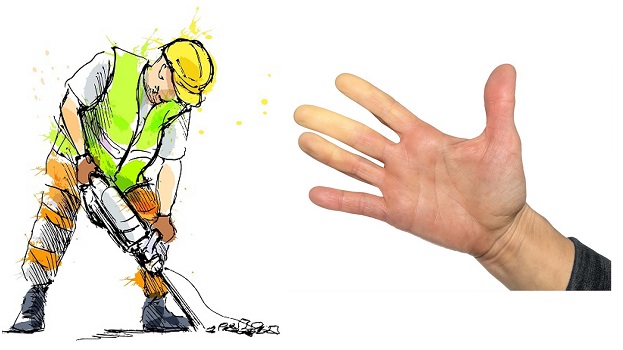Here we share the facts about hand-arm vibration syndrome (HAVS) – the risks, the causes and what can be done to prevent it.

What are the symptoms?
HAVS is a disorder of the blood vessels, nerves and joints. The most common symptoms are focused on the hands: loss of feeling, blanching (skin going a paler colour) and developing a weaker grip. Finger blanching (see picture) may be triggered by exposure to a humid or cold environment and can be painful. Clumsiness and reduced dexterity can also be symptoms – a result of nerve damage in the hands. There may be severe pain and cramps. Developed vibration injuries cannot be cured, medically or surgically. But if vibration injuries are identified early, anyone affected may recover.
What causes HAVS?
Exposure to vibration, typically from using equipment such as hand-held power tools over a long time. The tendency to develop HAVS varies between people. Some may get symptoms after a few years of vibration exposure, while others work for decades without problems.
Who is at risk?
Anyone whose role exposes them to vibration from hand-held power tools – such as in maintenance, construction, welding and electrical work. In general those at greatest risk have most exposure to vibration (intensity or length of time). This includes anyone using high-vibration equipment for long periods: impact wrench, shovels, disc saws, rock drills, chain saws, concrete breakers, strimmers, chipping hammers, needle guns and portable grinders. In the rail industry, data from RIDDOR (Reporting of Injuries, Diseases and Dangerous Occurrences Regulations 2013) showed 91 HAVS cases in 2018/19. For the past nine years it has been the mostly commonly reported occupational health condition.
What can be done to prevent it?
Employers must protect workers from risks caused by vibration. The Control of Vibration at Work Regulations 2005 require employers to carry out a HAVS risk assessment, and to provide information, instruction and training to employees on the risk and control measures. Those using tools should understand Exposure Action Levels (when to manage vibration exposure) and Exposure Limit Values (when to stop exposure) based upon a tool’s vibration intensity and the length of use. Organisations focus on either removing the risk of vibration exposure at source or reducing it to as low a level as is reasonably practicable. It might be possible to change the tools or methods to prevent irreversible vibration injury. Examples:
- using block splitters instead of cut-off saws
- bursting or crushing instead of pneumatic drilling
- isolating workers from tasks creating vibration, such as using a breaker attachment for an excavator or remote-controlled equipment instead of a hand-held breaker.
If you are concerned about HAVS where you work, and want to speak up in confidence, remember that you can
raise a concern or ask a question for your employer through CIRAS.
